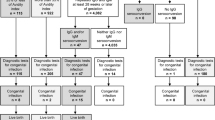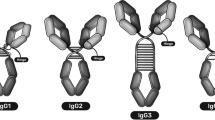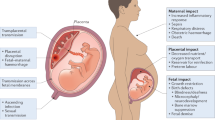Abstract
THE IgG of the neonatal human infant is almost entirely derived by selective transplacental passage of maternal IgG, but IgA and IgM are considered incapable of transplacental passage. In spite of immunological immaturity, the human foetus has been shown to produce antibodies, predominantly IgM, in response to various bacterial and viral antigens1,2. The very low level of IgM detectable at birth is of foetal origin1. IgA is synthesized by the foetus in exceedingly limited amounts, for only very low concentrations of IgA in cord serum have been detected by highly sensitive techniques. Nonetheless, small amounts must be synthesized by the foetus because immunization of pregnant women to IgA is not infrequent. We have observed that about 15 per cent of the mothers of recently delivered babies have antibody to IgA (anti-IgA) detectable in their sera (unpublished observations). Similarly, Cassidy et al. have also observed anti-IgA in sera of women who have never received parenteral injection of IgA in the form of blood or blood products3. Such antibodies may be directed against the allotypic antigens of IgA.
This is a preview of subscription content, access via your institution
Access options
Subscribe to this journal
Receive 51 print issues and online access
$199.00 per year
only $3.90 per issue
Buy this article
- Purchase on Springer Link
- Instant access to full article PDF
Prices may be subject to local taxes which are calculated during checkout
Similar content being viewed by others
References
Schultze, H. E., and Hermans, J. F., Molecular Biology of Human Proteins, 1, 532, 533, 556 (Elsevier, Amsterdam, 1966).
McCracken, jun., G. H., Chen, T. C., Hardy, J. B., and Tzan, N., J. Pediat., 74, 378 (1969).
Cassidy, J. T., Petty, B., Burt, A., and Sullivan, D., Clin. Res. (Abstr.), 17, 351 (1969).
Vyas, G. N., Perkins, H. A., and Fudenberg, H. H., Lancet, ii, 312 (1968).
Vyas, G. N., Holmdahl, L., Perkins, H. A., and Fudenberg, H. H., Blood (in the press).
Schmidt, A. P., Taswell, H. F., and Gleich, G. J., New Engl. J. Med., 280, 188 (1969).
Vyas, G. N., and Fudenberg, H. H., New Engl. J. Med., 280, 1073 (1969).
Vyas, G. N., and Fudenberg, H. H., Clin. Res. (Abstr.), 17, 469 (1969).
Tomasi, jun., T. B., and Bienenstock, J., Adv. Immunol, 9, 1 (1968).
Fudenberg, H. H., Kunkel, H. G., and Franklin, E. C., in Proc. Seventh Cong. Intern. Soc. Blood Transfusion (edit. by Holländer, L.), 522 (Karger. Basel, 1959).
Author information
Authors and Affiliations
Rights and permissions
About this article
Cite this article
VYAS, G., LEVIN, A. & FUDENBERG, H. Intrauterine Isoimmunization caused by Maternal IgA crossing the Placenta. Nature 225, 275–276 (1970). https://doi.org/10.1038/225275a0
Received:
Issue Date:
DOI: https://doi.org/10.1038/225275a0
This article is cited by
-
Spontaneous DNA synthesis of blood lymphoid cells in premature newborn infants, in older premature infants and in full-term newborn infants
Zeitschrift f�r Kinderheilkunde (1974)
Comments
By submitting a comment you agree to abide by our Terms and Community Guidelines. If you find something abusive or that does not comply with our terms or guidelines please flag it as inappropriate.



